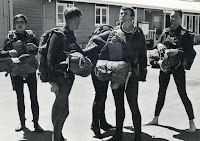But it didn’t get much worse than this – the front page headline story in The Advertiser on Monday, February 12, 1968 reported on the death of local parachutist Max Chaplin, who drowned the day before while taking part in a scuba jump off West Beach.
Max Chaplin was one of the original SA skydivers who first jumped at Aldinga on November 19, 1961, marking the birth of the sport in this state.
The tragedy occurred at a time when parachuting wasn't even considered by the general public to be a sport – it was just a "daredevil" activity for people at the edges.
The old photographs (see below) of 1960s crowds on Adelaide's beaches marvelling at people descending from the sky, are fascinating, especially now that every man and his dog seems to have done a tandem jump and thinks (with some justification) that it's ultra-safe.
Pioneers like Max Chaplin, however, were in at the birth our sport – and deserve to be remembered.
Here's the full story from The Advertiser
on mass airdrop
The Advertiser, February 12, 1968
While hundreds of people watched from the beach, a skydiver vanished in the sea off West Beach yesterday after he and four others had parachuted from 3,400 feet wearing diving and underwater breathing equipment.
The skydiver, George Maxwell Chaplin, 45 of Osborne avenue, St. Marys, is believed drowned.
He had sufficient air in his scuba equipment (self-contained underwater breathing apparatus) for 10 minutes under water.
 |
| Photo taken at Parafield by David Formby before the fatal jump: Max Chaplin (centre, partly obscured) checking the gear of Bruce Marshall. Rod Evans (left) and Col Parsons (right). |
The most experienced skydiver in the club, Mr Chaplin was in charge of the drop.
He was also a leader of the St. John Ambulance Brigade parachutists' squad. Mr. Chaplin was one of a "stick" of three skydivers who leaped from a single-engined Cessna aircraft at about 2 p.m.
Two others leaped a few seconds later from a similar aircraft. Waiting on the water were five surfboats each carrying a skin diver assigned to enter the water to accompany a skydiver as he landed.
Although the skydivers landed in a 200-yard group, it is believed that gusting winds carried them about a quarter of a mile from the target area.
This delayed the arrival of the surfboat and skin divers at the landing points and when they arrived there were only four skydivers on the surface.
 |
| Max Chaplin's last exit. Photo by David Formby from a second aircraft carrying other skydivers on the jump. |
Each surfboat was marked with a number corresponding with the jumping order of a parachutist.
The skydivers were supposed to hit the water as close as possible to their respective boats and unbuckle their parachutes just before hitting the water.
Then they were to swim towards their boats to be picked up.
Plane search
When it was discovered that Mr Chaplin had not surfaced a full-scale search was started.
Off-duty members of the Police Aqualung Squad were called in and went to the scene. All five surfboats continued to search until dusk and the 5AD Surf Patrol aircraft circled the area for most of the afternoon to help in the search.
Several lone surf skiers also joined in.
Mr Chaplin's main and reserve parachutes were found soon after the search started, but no sign had been found of him by dusk, when the search was stopped for the night.
 |
| Beachgoers watch the 1962 para-scuba jump off West Beach. Two canopies are still in the air. |
A member of the skydiving club, Mr D. J. Formby, of Diagonal road Warradale, was in the second aircraft taking photographs of the descent.
He said it had been planned that the parachutists would leave the aircraft at one-second intervals, but the first to jump, Mr. Rod Evans, left the first aircraft well before the second, Mr. Chaplin. [Other members of the "para-scuba" team were Fred Rothe, of North Adelaide, Colin Parsons, of Glenside, and Bruce Marshall, of Beverley.]
"I assumed he had got a bit tied up in the plane, but he jumped after perhaps 10 seconds," Mr Formby said.
“Fanatic”
“Max was an absolute fanatic for planning to the last detail, and safety was his main consideration.
“He never took risks with his own or anyone else’s safety, and he told me this jump was perfectly planned.
 |
| Surf boats return to the beach after the jump. |
“Each boat crew thought the other had picked him up and none of them had.
“That time he managed to stay afloat until they realised he was not in any of the boats.”
An observer, Mr W.A.B. Lemon of Garnet avenue, Blackwood, said he believed the failure to pick up Mr. Chaplin could have been caused by confusion.
“I heard that someone had told his boat crew he had been picked up by a speed boat, and since he wasn’t around the crew returned to the beach with the others,” he said.
“There was also a rumour that he was on Henley Beach, presumably where the fictitious speed boat had dropped him.
“Both these stories later turned out to be wrong.”
Footnote: Max Chaplin's sister Shirley honoured his memory 40 years later, making a tandem jump at Goolwa with tandem master Mark Gazley on January 5, 2010, marking her own 82nd birthday.
The event was noted by the local Southern Times Messenger newspaper, which published a report on its website, including a link to YouTube footage, shot by Nicki Dowden.
Here's their story and video in full >>
###
Share
skydive skydiver skydiving parachute parachuting parachutist freefall Adelaide South Australia






0 comments:
Post a Comment